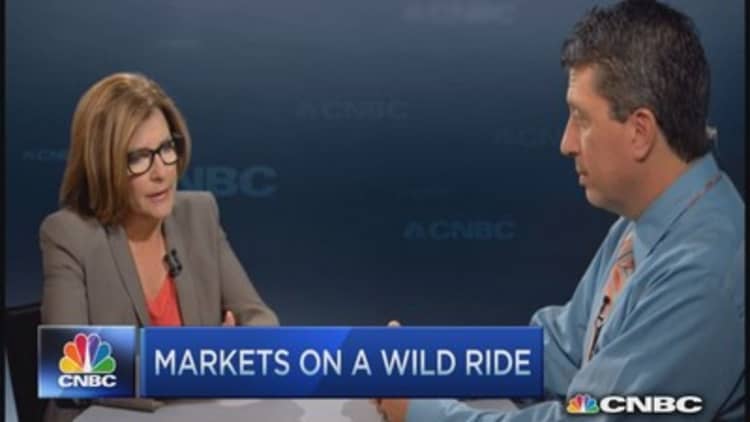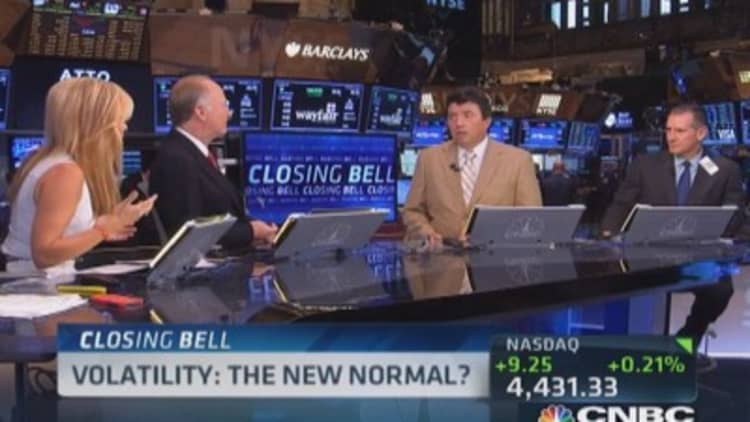
What is making the market volatile is pretty obvious. What is likely to keep it volatile is a little less so.
Wall Street pros have trotted out all the usual suspects to explain why the major averages have wiped out almost all their gains for the year: Europe, Ebola, ISIS and a pick-your-poison menu of other headwinds that have made a world full of promise suddenly appear to be a minefield without a map.
Read MoreCorrection watch: Here are the levels to watch
Underlying the investing climate is a general level of uncertainty.
A growing chorus of investors worry not simply that the world is changing but is doing so in ways for which policymakers are not prepared. How does the Federal Reserve unwind its massive easing measures? What happens if things don't go as planned? In the case of a big scare, particularly in the fixed income market, will a lack of buyers turn a selloff into a stampede?
"We're seeing this move for the third time," Peter Boockvar, chief strategist at The Lindsey Group, said in reference to the Fed likely exiting the third leg of its quantitative easing bond-buying program this month. "People are acting like they've never seen this before. This is what happens when QE ends. All the warts and blemishes start to matter."
Indeed, there are warts and blemishes aplenty, even amid the wine and roses.
Greece sparked the most recent euro zone worry when leaders there announced what amounts to a go-it-alone strategy—minus central bank assistance—in righting its ship.
Meanwhile, investors jump each time it appears the Ebola scare is spreading. And to top things off, the supposedly sacrosanct U.S., which is expected to rise above the global economic weakness, has problems of its own, particularly in terms of consumer strength as evidenced by September's anemic retail sales numbers released Wednesday.
Read MoreCapitulation? Market drops on weak data, snaps back
Looking at the big picture, Boockvar believes that the downdraft in stocks is just getting started.
"This is not your standard 5 or 6 percent correction," he said. "This is going to be the first 10 percent correction we've had in a long time—at least."
But while equities get the most headlines, the reaction in the fixed income markets may be even more telling.
German bund yields slumped Wednesday prior to the U.S. market open while Greek yields spiked. For its part, the benchmark U.S. 10-year Treasury note briefly slid below 2 percent—where it has not closed since May 21, 2013—in what Boockvar called a pure safety play amid global turmoil.
"It's the classic flight to safety," Boockvar said. "When you're in a flight-to-safety trade, people are more worried about safety than the smarts of it."
Read MoreEurozone crisis 2.0? Greek stocks tank
The massive decline comes the same week that a Bank for International Settlements official expressed fears over a "violent" market drop, particularly in bonds.
"If I had told you that there were heightened tensions in the Middle East and Eastern Europe, uncertainty about the turning point in U.S. monetary policy, a succession of strong U.S. job numbers, uncertainty about the future direction of policy in Europe and Japan, as well as increased concern about the strength of the Chinese economy, you would not be expecting that to make for a benign time in financial markets," Guy Debelle of the BIS said, according to prepared remarks for the Australian and New Zealand Investment Conference on Tuesday. "But that is what we have seen for much of this year."
Debelle's fears over market stability stem not only from those factors but also from a lack of liquidity in the fixed income markets—remarks that mirrored those from the TABB Group's Anthony Perrotta, who warned last week of a "doomsday" scenario shaping up in fixed income.
A "reason to suspect that the selloff might be violent is the starting point, namely zero nominal interest rates," he said. "That is a point we haven't started from before (with the possible exception of Japan). There are undoubtedly positions out there which are dependent on (close to) zero funding costs. When funding costs are no longer zero, those positions will blow up. Where are they? How large are they?

"I don't really have a good answer to those questions. It appears more likely that they are held by real money investors than directly on the balance sheets of the core banking system, which is probably a good thing. But then if we think back to 2007, structured investment vehicles weren't directly on the balance sheet of the core banking system either."
The result: Financial markets faced with uncertainty that isn't going away. The Europe slowdown is probably in the early innings, the Fed hasn't even begun to raise interest rates yet, and geopolitical crises seem to pop up by the day.
Investors, then, may not want to sell into the weakness, but they for sure had better be paying attention.
Read MoreAfter VIX 'super spike,' is the worst ahead?
"It's all occurring at a time when you have some expensive financial assets out there. That makes for a pretty volatile mix," said Gary Pzegeo, managing director at Atlantic Trust Private Wealth Management. "If you get a new piece of information and you get a big seller, there are lots of people who are watching the market, see the prices and are quick to pull the trigger."
Pzegeo believes the bull run that began 5½ years ago remains intact, but sees "a new and more challenging phase ahead" exacerbated by potential liquidity events the likes of which Debelle and others have cited.
"You have to be careful that liquidity events don't turn into fundamental events," he said. "You have to watch some of the markets that have been founded on very liquid (conditions) and make sure that they're still functioning—that this does not spin into something worse."






